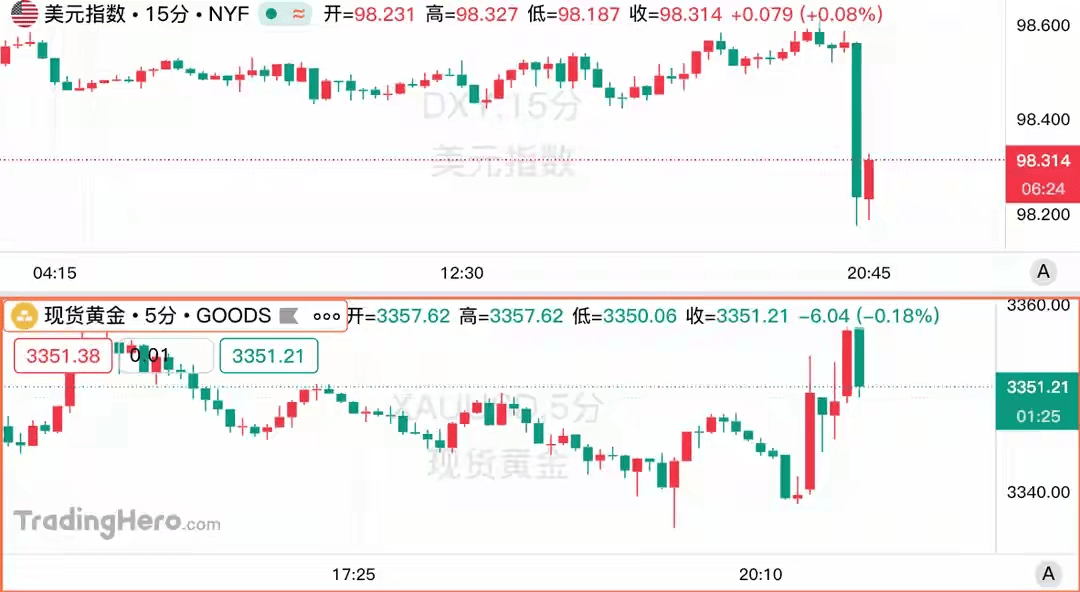The latest U.S. CPI data has been released, leading the market to increase bets on a rate cut in September. However, the core inflation year-on-year unexpectedly soared to a five-month high, with analysts remarking, 'This is not a good sign'…
At 20:30 Beijing time on Tuesday, the U.S. July non-seasonally adjusted core CPI year-on-year rose further to 3.1%, a five-month high, exceeding the market expectation of 3.0%. The core CPI month-on-month rose further to 0.3%, the highest since January, aligning with market expectations and above the previous value of 0.20%.
The overall CPI year-on-year recorded 2.7%, below the expected 2.8%, consistent with the previous value. The month-on-month CPI recorded 0.2%, meeting expectations and lower than the previous value of 0.30%.
After the data was released, spot gold soared to a peak of $3354 per ounce, significantly retreated, and then surged again; the dollar index fell over 30 points in the short term; non-dollar currencies rose broadly, with the pound breaking above 1.35 against the dollar; the dollar fell below 148 against the yen; and the euro rose nearly 50 points against the dollar in the short term.
U.S. short-term interest rate futures fell as traders increased their bets on a Federal Reserve rate cut in September, continuing to bet on a rate cut in December.
Analyst Anstey stated that this is the first month in six months where the monthly core CPI reading failed to fall below the expected median. The question is whether this is a turning point, with inflation set to begin exceeding expectations in the coming months; the July core CPI was slightly above expectations, and Federal Reserve Chairman Powell has been saying that policymakers are focused on 12-month inflation. So, this is not a good sign.
"The 'super core services' indicator—once a focal point for Federal Reserve policymakers—became a significant driver of inflation in July. This indicator excludes housing, goods, food, and energy costs, rising by 0.48% that month. This is the largest increase since January and the second-largest in 16 months. We have rarely seen such a significant jump recently."
Airfare prices are a significant factor in the rise of 'super core services'. The 4% increase in this category this month is the highest level in over three years. Another category pushing this indicator up is dental services, which saw a historic increase of 2.6%.
Anstey stated that new car prices remained flat this month. Katherine Judge from CIBC Capital Markets mentioned that the auto industry expects prices to rise when new models hit the market this fall. 'We expect new car prices to rise due to tariffs, as new models enter dealer showrooms and stocks before the tariffs are implemented gradually decline.'
Economists have been monitoring whether categories like furniture are affected by tariffs. This category rose by 0.7% this month, indicating a slight slowdown in the growth rate. Nevertheless, its year-on-year increase of 2.4% still set a new high in two years.
Video and audio products are another category closely monitored for tariff impacts. The monthly increase was 0.8%, the smallest since May, similar to furniture prices. Year-on-year, the increase was 0.4%, which may not sound like much, but it is the largest increase since 2021.
Clothing prices rose 0.1% month-on-month, marking the smallest increase since May. From a tariff impact perspective, at least preliminary observations indicate that its impact has not strengthened and may even have slightly weakened.
It is worth noting that the two categories frequently emphasized by Trump—grocery and energy costs—both declined in July. Household food prices fell by 0.1%, while energy prices decreased by 1.1%, with gasoline prices dropping by 2.2%.
Analyst Jersey's initial view on the July U.S. CPI report is that the Treasury market seems concerned about rising CPI, but the overall monthly CPI data indicates that the PCE data received before the September meeting may be close enough to the 2% target, allowing the Federal Reserve to loosen monetary policy in September. Jersey said, 'We still believe the market is expected to rise further.'
"As new highlights in the job market fade, perhaps merely avoiding an unexpected rise in inflation will be enough for the market to continue digesting more rate cuts," said Zachary Griffiths, head of investment-grade and macroeconomic strategy at CreditSights. "Overall, we believe this statement is neutral, but still expect the Federal Reserve to cut rates in September, with our baseline prediction being a more substantial cut of 50 basis points, as the labor market has become the focus of policymakers."
